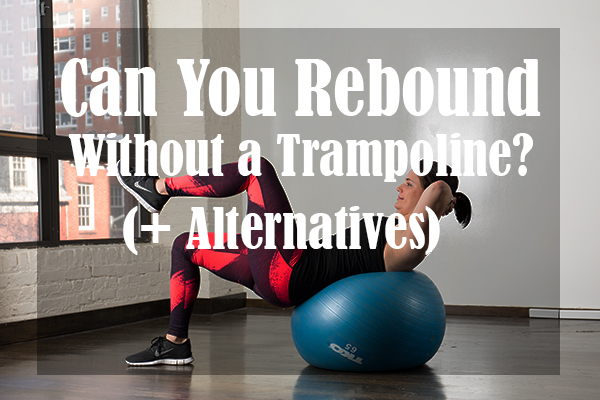
Can You Rebound Without a Trampoline? (+ Alternatives)
For those who like using a mini trampoline (rebounder) to exercise, this option may not be available at all times. Maybe they can’t bring it or simply don’t have one. So the question is — can one rebound without a trampoline? The short answer is — yes, they can.
A mini trampoline sure is useful, but is it absolutely necessary? After all, they have been around for almost 40 years. That means there were ways to go without them.
In this article, we’ll talk about some rebounding alternatives. Also, we’ll cover a few rebounding exercises one can do without a trampoline.
Rebounding Alternatives
The Swiss Ball

One of the most common fitness tools is the Swiss ball. This exercise ball allows for bouncing. Not only that, but one can do many other exercises with it. Some even claim it’s more fun than the actual rebounder. The cheapest Swiss ball costs around $13. However, the cheapest is not always the best.
Using the Swiss Ball for bouncing is quite simple. Moreover, some claim it also burns calories quickly. One should sit tall on the exercise ball with their feet on the floor. Their knees should form a 90-degree angle. However, it’s not bouncing down that counts. Actually, one should bounce up, letting their feet separate from the floor. The exercise usually lasts about five minutes. Yet we’ll let our readers determine how much time they need. Throwing in a few different arm movements would also help.
Gymnastics Springboard

The gymnastics springboard gives us an additional boost when making leaps. However, it can also help us rebound. We should find a springboard with longer springs to get more bounce. It is good for doing the so-called “health bounce.” That means our feet will barely lift off while bouncing. Moreover, it will prevent us from bouncing too high and losing balance. However, gymnastics springboards are not at all cheap. On the other hand, if we have one lying around, it will serve just as well as a rebounder would.
The Bed
Most of us loved jumping on the bed when we were kids. However, the bed can also serve as a rebounding alternative. Most mattresses contain springs, with the exception of memory foam ones. Moreover, some beds even have flexible boards underneath, so the bed should be a viable alternative if used correctly.
But what do we mean when we say “correctly”? By that, we mean one should first check the overall stability of the bed. Old and rickety beds are out of the question. Moreover, any mattress with protruding springs could cause injuries. Finally, one should take their weight into account as well.
Once we are sure the bed is stable enough, we can start bouncing. The routine is essentially the same as with a mini trampoline. However, if we are not completely confident, we can bounce without lifting our feet off the bed. Additionally, we can move our arms while jumping. Finally, some say this is a great rebounding alternative when one is staying at a hotel.
The Floor
Sometimes, simple is good. Bouncing on the floor is a no-brainer. However, we do recommend bouncing on a softer surface, like a carpet. Additionally, a rubber mat will help. Overall, a soft surface is more comfortable for the ball of the foot. Many gyms have rubber floors for that and other reasons. Hardwood floors come into question when we are wearing shoes.
We should keep our arms relaxed next to our body, our back straight, and the knees slightly bent. Also, our feet should be slightly apart. From there, we can start rebounding. If we have enough space, we can also throw in a skipping rope. This combination will stimulate both the arms and the legs. Moreover, since the floor is less bouncy than a rebounder, our shin muscles will work harder. Yet we should take occasional pauses, lest we get shin cramps.
The Swimming Pool

While swimming is a great exercise per se, we can also bounce while we’re in a pool. Go to the deep end and hold on to the edge. Additionally, we can get a foam noodle or a floaty to hold on to while bouncing.
What’s great about this rebounding alternative is the water itself. It gently massages our body, more importantly, our lymph nodes. Moreover, water makes us feel lighter, making the exercise much easier. In fact, even people with bad knees can enjoy it. For additional lymph drainage, we might want to submerge our neck as well.
Sponge

Finally, a bigger piece of sponge is a soft alternative to a rebounder. While not as effective, sponge is a soft material. Moreover, thicker pieces have more bounce to them. Aside from the thickness, we can also choose how soft the sponge is.
Aside from using a whole sponge panel, we can also buy sponge bits, which are commonly used to fill pillows. We can even take a bigger bag and stuff it full of them. Then, we can use the bag as a rebounding alternative.
Final Thoughts
Rebounding is praised by fitness experts and medical professionals alike. It helps improve our health in a variety of ways. The mini trampoline usually serves that purpose, but we can do rebounding exercises even without one. Whether it’s on the floor, on the bed, or a springboard, there is a variety of rebounding alternatives. However, safety is important!
Please share this article and tell us in the comments which rebounding alternative works for you!
Our Rebounder Recommendations | Our Rating | Images (click for more) |
|---|---|---|
94 | ||
93 | ||
90 |




